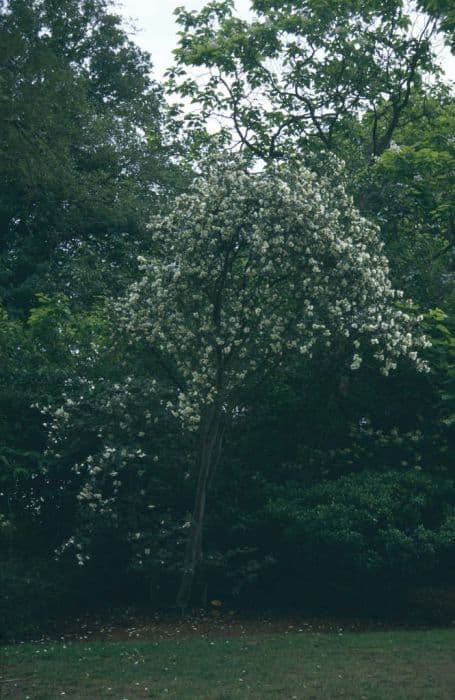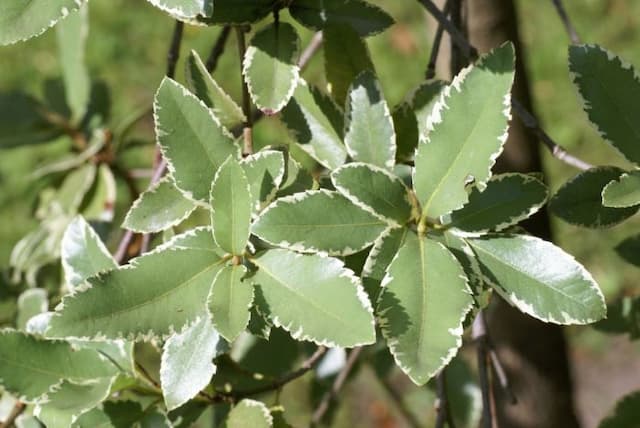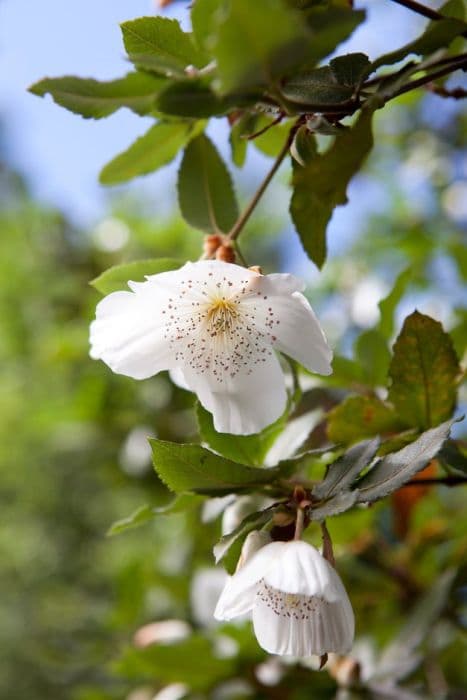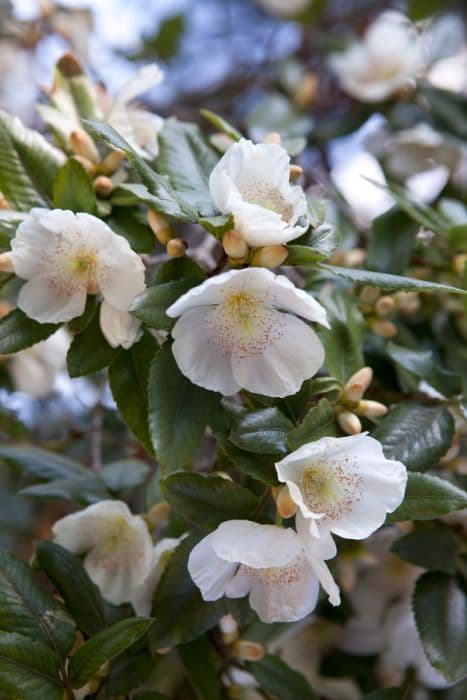Nymans eucryphia 'George Graham' Eucryphia × nymansensis 'George Graham'

ABOUT
'George Graham' is an evergreen tree of dense, broadly columnar habit, with dark green leaves composed of one to three oblong leaflets, and rose-like, white flowers 6cm wide in late summer and autumn. It typically flowers two weeks later than 'Nymansay'
About this plant
 Names
NamesFamily
Cunoniaceae.
Synonyms
Nyman's Eucryphia, George Graham Eucryphia.
Common names
Eucryphia × nymansensis 'Nymansay'.
 Characteristics
CharacteristicsLife cycle
Perennials
Foliage type
Evergreen
Color of leaves
Green
Flower color
White
Height
20 feet (6 meters)
Spread
10 feet (3 meters)
Plant type
Tree
Hardiness zones
8
Native area
Cultivar
Benefits
 General Benefits
General Benefits- Ornamental Value: Eucryphia × nymansensis 'George Graham', also known as 'Nymansay', adds aesthetic appeal to gardens with its beautiful white flowers.
- Attracts Wildlife: The flowers provide nectar for bees and other pollinators, supporting biodiversity.
- Seasonal Interest: Offers a display of blossoms typically in late summer when many other plants have finished blooming.
- Low Maintenance: Once established, 'Nymansay' requires relatively little care, making it suitable for low-maintenance landscaping.
- Drought Tolerance: It has some level of drought tolerance, which is beneficial in areas with water restrictions or dry climates.
- Privacy Screen: Can be used as a hedge or screen, providing privacy and reducing noise pollution.
- Shade Provider: Larger specimens can offer shade in gardens, which can help in reducing local temperature and providing a cool area during hot weather.
 Medical Properties
Medical PropertiesThis plant is not used for medical purposes.
 Air-purifying Qualities
Air-purifying QualitiesThis plant is not specifically known for air purifying qualities.
 Other Uses
Other Uses- Eucryphia × nymansensis 'George Graham', commonly known as Nyman's eucryphia, can be used in woodworking for crafting small decorative items, due to its fine, even-textured wood.
- The plant's wood, being relatively hard and dense, is sometimes used in the production of specialty musical instruments such as wooden flutes or recorders.
- Due to its slow growth and fine grain, Nyman's eucryphia can be utilized in making precision tools or equipment where stability and fine detail are required.
- In landscape design, Nyman's eucryphia is used to create focal points in gardens due to its striking summer blooms.
- The blossoms can be used as a natural fabric dye, giving textiles a soft yellow to creamy hue.
- Carving enthusiasts may seek out the wood of Nyman's eucryphia for detailed carving projects, as it holds intricate details well.
- When dried, the leaves of Nyman's eucryphia can be included in potpourri mixes for a subtle woodsy fragrance.
- Its dense foliage is sometimes used by gardeners to create shelter belts or windbreaks in landscape schemes.
- The wood can also be employed in the making of fine inlays or veneers for cabinet-making and marquetry work.
- Photographers may use the plant as a backdrop for nature photography, especially when it is in full bloom, providing a lush and vibrant setting.
Interesting Facts
 Feng Shui
Feng ShuiThe plant named Nymansay's Eucryphia is not used in Feng Shui practice.
 Zodiac Sign Compitability
Zodiac Sign CompitabilityThe Nymansay's Eucryphia is not used in astrology practice.
 Plant Symbolism
Plant Symbolism- Resilience: Eucryphia × nymansensis 'George Graham', commonly known as the Nyman's eucryphia, often symbolizes resilience due to its vigorous growth habits and ability to thrive in various conditions.
- Rarity: Given that this is a specific hybrid, it may represent the uniqueness or rarity of a condition or individual, celebrating the singular nature of something uncommon.
- Evergreen Quality: As the Nyman's eucryphia is an evergreen, it symbolizes perpetual life and immortality, reflecting the continuity and everlasting aspects of nature or the human spirit.
- Purity: The white flowers of the Nyman's eucryphia can symbolize purity and innocence, echoing the clarity and simplicity of its blooms.
- Beauty: With its attractive flowers and form, the Nyman's eucryphia could represent beauty and appreciation for aesthetics, signaling the importance of beauty in life and nature.
 Water
WaterThe Nyman's Eucryphia should be watered deeply and thoroughly, making sure the soil is evenly moist but not waterlogged. It's essential to allow the top inch of soil to dry out between waterings, which typically means watering once every 7 to 10 days during active growth in the spring and summer. During the dormant period in the fall and winter, reduce watering to every 2 to 3 weeks. Depending on the size of the plant and the weather conditions, you might use 1 to 2 gallons of water per week during the growing season.
 Light
LightThe Nyman's Eucryphia thrives in full sun to partial shade conditions. It prefers a spot that gets at least 4 to 6 hours of direct sunlight per day, with dappled light or partial shade during the hottest part of the afternoon to prevent leaf scorch.
 Temperature
TemperatureNyman's Eucryphia does well in moderate temperatures and can tolerate a range between 32°F and 75°F. Ideal growing temperatures are between 50°F and 70°F. It's important to protect the plant from extreme cold and frost, which may damage new growth.
 Pruning
PruningNyman's Eucryphia should be pruned to maintain its shape and remove any dead, diseased, or crossing branches, which improves the plant's overall health and appearance. The best time to prune is late winter or early spring before new growth begins. Prune sparingly, as excessive cutting can reduce flowering.
 Cleaning
CleaningAs needed
 Soil
SoilNyman's Eucryphia prefers moist, well-drained soil with a mixture of loam, peat, and sand to ensure good drainage. It thrives in acidic to neutral pH, ideally ranging from 5.0 to 7.0.
 Repotting
RepottingNyman's Eucryphia, being a larger shrub, is not commonly repotted and is typically planted directly into the ground. Repotting is usually not applicable for this species.
 Humidity & Misting
Humidity & MistingNyman's Eucryphia benefits from moderate humidity but is quite adaptable and can tolerate a range of humidity conditions typical of temperate climates.
 Suitable locations
Suitable locationsIndoor
Not suitable for indoor growth due to size.
Outdoor
Plant in moist, well-drained acidic soil; full sun to partial shade.
Hardiness zone
7-9 USDA
 Life cycle
Life cycleEucryphia × nymansensis 'George Graham', commonly known as the Nyman's eucryphia, begins its life cycle as a seed, which upon germinating in suitable conditions, develops a root system and shoots, emerging as a seedling. As it grows, it enters the vegetative stage, forming a woody structure with glossy, dark green leaves and gaining height and girth over several years. Following the juvenile period, it reaches maturity and begins the reproductive stage, typically producing highly scented, white flowers in late summer, which, if pollinated, will develop into fruit capsules containing seeds. The plant has a perennial life cycle, potentially flowering annually and setting seeds, which can then disperse and give rise to new plants, completing the cycle. Over time, the Nyman's eucryphia may experience senescence, where older parts may die back, but the plant can continue to live and reproduce for many years. This species is also often propagated through cuttings, which can bypass the seed stage and create clones of the parent plant.
 Propogation
PropogationPropogation time
Late winter-early spring
The most popular method of propagation for the Eucryphia × nymansensis 'George Graham', commonly known as Nyman's Eucryphia, is through semi-hardwood cuttings. Typically, this is done in late summer when the current season's growth has started to harden but is not yet fully woody. Cuttings should be about 4 to 6 inches (10 to 15 centimeters) long, taken with a sharp knife to ensure a clean cut. The lower leaves are stripped, and the cut end is often dipped in a rooting hormone to facilitate root development. Then, the cuttings are inserted into a potting mix that drains well. They require a consistent high humidity environment, which can be maintained by covering the cuttings with a plastic dome or using a mist system. The pot should be kept in indirect light until the cuttings have rooted, which can take several months.




